SIMPLY BELIZE: A Cultural Diary
EPISODE: # 3 - Q'eqchi Maya
DURATION: 32 minutes
DATE AIRED : 28/5/2002
|
HOST: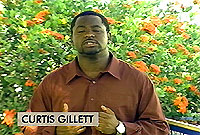
Hello! Welcome to episode three of SIMPLY BELIZE: A Cultural Diary. I'm your host, Curtis Gillett and tonight we travel South - to the Toledo District - to meet the largest and most traditional group of Mayas in Belize - the Q'eqchi' Mayas.
Blue Creek, Toledo, Jan 29, 2002
HOST:
Jose Kal is performing a spiritual ceremony at the inauguration of a new school in Blue Creek - the Tumul K'in Center of Learning. He and his brother, Francisco, the man kneeling beside him, are "curanderos", traditional Mayan healers whose intimate knowledge of the healing powers of local plants and prayers attract many sick people to their homes on a regular basis.
Today they have been invited by the Toledo Maya Cultural Council, not to heal any specific sickness, but to bless the new school, to prevent anything bad from happening in the future.
So they light multicolored candles, burn various incenses and offer prayers to the "grandparents" - the term that the Mayas use to refer to their ancestral spirits. In return, the students of Tumul K'in should get good health and good teachers.
MAYA SPIRITUALITY
HOST:
The Mayas have four primary colors - Red, White, Black and Yellow - and two secondary colors - Green and Blue.
The four primary colors are associated with various groups of elements that are sacred to the Maya: four cardinal points, four varieties of corn grains and the four biological elements of the human body - blood, hair, skin and bone. The secondary colors represent the overall source of life. Green symbolizes the rainforest, the environment and Mother earth while Blue represents heaven, God or an overall creator.
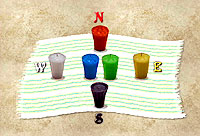
The four primary colors are placed at the four cardinal points while the two secondary colors are placed in the middle to represent the center of the universe.
It takes only a few minutes for this offering to go up in smoke, but several days to prepare for it.
…BEFORE THE CEREMONY
HOST:
Our first stop was Punta Gorda, the southernmost town of Belize. Punta Gorda is the only town in the Toledo district and serves as an administrative and commercial center for approximately 8,000 Q'eqchi' Mayas. But despite the heavy Mayan presence here, the "curanderos" cannot find all the materials they need for a Mayan spiritual ceremony. So Francisco Kal will have to make a special trip across the border. With more than 750,000 Q'eqchi's living in Guatemala, everything required is readily available at the central market in San Luis, Peten.
Anticipating a full day's journey, Don Francisco sets off at 5:30a.m. Starting from his home in Punta Gorda, he travels for 13 miles along the Southern Highway until he reaches the area called "Dump". Here he turns off the paved highway and continues for the next 25 miles or so on a bumpy, pot-holed road past the villages of Mafredi, San Antonio, Santa Cruz, Santa Elena and Pueblo Viejo until he reaches Jalacte, a village situated next to the Guatemalan border.
It is almost 8 a.m. when he starts walking across the border. But he is not alone. Many of the Q'eqchi' Mayas who live in Belize are related to those who live in Guatemala. And for them the border is not really an issue. It is only a muddy river that has to be crossed in order to visit their family and friends or to indulge in small trade much like their ancestors did many centuries ago.
Don Francisco will walk for another 40 minutes before he meets up with a minibus taxi that will take him for the 2-hour drive into San Luis, Peten. It will be another 6 hours before he returns.
Jose Kal is a licensed Mayan sacerdote who lives in Jalacte. He is also Francisco's brother, and the curandero who will actually perform the ceremony in Blue Creek tomorrow. Francisco has asked him to lead the ceremony in his place because he knows he will be tired after today's trip. Healing requires a certain amount of concentration and a good curandero should rest both his mind and his body before calling on the spirits of the grandmothers and grandfathers for help.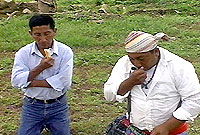
Francisco will bring back multicolored candles to represent the various primary and secondary colors. A red candle placed North will represent the rising sun, a black candle placed South symbolizes nightfall, a yellow candle in the East shows where the water comes from and a white candle to the West is the air. Then green and blue candles will be placed in the center to represent Mother earth and the sky respectively.
This is "insarte". It is placed at the cardinal points. The large ball next to it is called "bola". Then there's "wacalito". According to Kal, it is called this because it looks like one of the old fashioned cups that the ancestors used to drink out of. Next there is "cascarita". Some people call it "palito. This is sprinkled in a circle.
Then there is the "copal palm" - a very important part of any Mayan ceremony. The copal is placed in the center of the circle to represent the very essence of water, sky, air and earth. This is "copal incense". It is always burned along with the copal palm.

"Wilcu" looks like coins. So, the healers use it as money. When they burn "wilcu" they say that they are paying the ancestors for the favour they are about to ask. "Romero" is sprinkled in a circle to get rid of pain. In this case, its purpose will be to prevent pain from entering the school compound. "Empiricon", "ocote"and "puro" will also be burned to avoid pain.
"Ajojolia" sprinkled in a circle means that you are asking for wealth or a good harvest. And "canela" or cinnamon, as it is known in English, has a calm soothing scent. Then there is "Florida water" and "Siete Machos". "Florida water" is sprinkled at the cardinal points and on the person or object that the ceremony is for. While "Siete Machos" - a sweet smelling perfume - just makes everything smell nice
MAYAN HISTORY?
PEDRO KUKUL Education Officer, Toledo: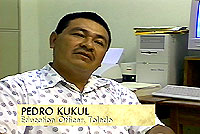
See when the explorers came they were looking for something. And when they met these groups of people they asked them if there was gold. And then the Mayas, now that we call Mayas, said well, "Mayap" meaning "We don't have." "There's no gold." And that's where the name actually originated according to some earlier people.
If you look at the history books that have been written they only mention the Mayas, but they have never been specific. And it's quite, I believe, an intentional effort to kind of like blur the whole history of Belize by just saying the Mayas.
GREG CHOC President, Kekchi Council of Belize: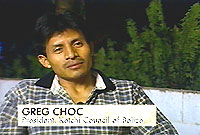
I've always been critical of the accounts of the Europeans during their conquest. For me personally, regardless of which tribe, which Mayan group occupied this particular area at the arrival of the Europeans, it is sufficient to conclude that the original settlers were Mayan. Our request for the recognition of our rights is founded on the recognition that we are the descendants of the Maya people living in this region prior to the arrival of the Europeans.
SUBSISTENCE FARMING
HOST:
Of the 36 Maya villages in the Toledo district today, 29 of them are Q'eqchi'. These are mainly subsistence farming communities that plant corn, beans and rice in order to feed their families. But contrary to popular belief not everything they grow is for personal use.
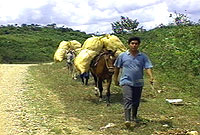
Excess crop is sold - either at the market in Punta Gorda or across the border in Guatemala - whichever happens to be closer. And the money earned is used to buy staples like coffee and sugar for early mornings at the milpa, as well as clothes and schoolbooks for the children.
In his book, Household Ecology, Economic Change and Domestic life among the Kekchi Maya in Belize Richard Wilk writes, "Almost every agricultural system includes both subsistence production and exchange of both products and labor. [And that] the Kekchi [in Belize] have by all accounts not had a 'pure' subsistence lifeway for well over 2,000 years, and for at least 400 years, many have worked off the farm part-time."
But even with part-time work most Q'eqchi' Mayas in Belize remain cash poor. More than likely, the little cash in hand will run out before the next harvest. So without money, how will they make it? City and town folks need cash in order to survive - even if it's just to buy bread. Without money in urban areas, you're forced to beg for food or starve.
But life in rural Belize is a bit different, especially if you're living in a Mayan village. Granted, without money, there won't be much variety to your diet, but at least there will be something to eat everyday.
But growing food for the family year round is hard work! And for the typical traditional Mayan farmer - without access to transportation - it is even harder. Family milpas - roughly 6 acres of land each - are located about 3 miles outside the village. Now some men will head out on their bicycles. However, most have no choice but to walk…and walk…for miles in the blazing sun - everyday! During harvest, they'll walk even more - back and forth from the milpa - several times a day carrying heavy bags of corn to be stored in the family home. There are of course, a few lucky ones with horses.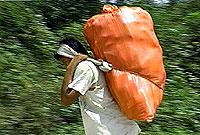
Most Maya villages in the South are still relatively isolated. So if you have plans to visit be prepared for a long bumpy ride on any of several dusty, pot-holed roads that feed off the Southern Highway. And during the rainy season, some of the villages further west like San Vicente, San Benito Pointe and Hicatee are so cut off from the rest of Belize due to rising rivers, that not even a 4 wheel drive will get you there.
So why did the Q'eqchi's establish their communities so far away from major roads?
PEDRO KUKUL:
As far as I know there has never been a confrontation between the British. What they did was they avoid it. They would move from one place to the next. You know, to avoid the contact, a contact with people who do not speak the Q'eqchi' language. So there was a language barrier and because of the language barrier, they could not really communicate. And because of that, you find out that Q'eqchi's were moving more and more towards the inland areas.
LANGUAGE & CULTURE
PEDRO KUKUL:
We have many people who can speak a little bit of English, just enough to get by. So I wouldn't want to say, that "Yeah, we speak English now, we can defend ourselves in the English language." I don't think we have enough people to really be able to defend themselves in the English language.
HOST:
Belize is an English speaking country. What this means is that all official documents and correspondence are written in English. So the Mayas, the original inhabitants of Belize - a multi-lingual people who can often speak several of the 23 Mayan languages - are being discriminated against for not speaking a European language.
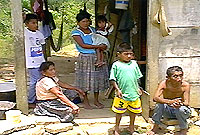
GREG CHOC:
Language is one of the main elements that defines a culture, defines a people. And hence most cultures, most indigenous people are trying to save that aspect because that on a whole, defines who they are, defines their identity. If you look at the historical aspect of how the Mayan languages - from the main Mayan languages - how the various dialects or the different languages started to separate and form, we found that the Q'eqchi' was one of the first languages that separated from the main Mayan language that existed prior to the arrival of Christopher Columbus. So it's like a thousand years old, the first language to separate from the main Mayan language.
HOST:
In the 19th Century a copy of the Popul Vuh - the Book of Council surfaced in highland Guatemala. This manuscript, dated to the 16th century, tells the story of creation and moves through eras that are marked by the Mayan calendar…continuing up until the end of time.
The Popul Vuh - the central book of mythology for all Mayas - was written in Quiche Maya. Curiously though, its writers used the Roman alphabet.
PEDRO KUKUL:
The first writers of the Q'eqchi' language were priests in Guatemala and they adopted the Spanish sound system completely. They wrote the language as they heard the language and therefore, they used to use sound symbols that were actually not reflecting the sounds of the language. What happened was that the academia of Mayan languages in Guatemala picked up the situation and they studied it. In order not to really shift away from the original reading and writing of the Q'eqchi' language they merely adapted or edited the different sound systems. What is happening now is that the new system is being encouraged. They are writing books now using the new sound system.
TRADITIONAL LAW
HOST:
Most Maya villages in Belize today are governed jointly by an alcalde and a 7-member village council. The alcalde is usually an elected village elder who functions in a judicial capacity, similar to that of a magistrate.
GREG CHOC:
He is not a leader as defined by the Western society. He is sort of a spokesperson. The authority rests with the community. He carries out the mandate from the community.
HOST:
The alcalde serves a two-year term. The village council members, on the other hand, are elected every three years and each village council is headed by a chairman.
ALFONSO CAL
Chairman, Golden Stream, Toledo:
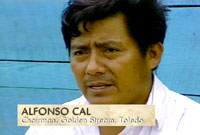 In our village we are working together, me and the alcalde. We work together because it's for the benefit of the village, you know.
In our village we are working together, me and the alcalde. We work together because it's for the benefit of the village, you know.
HOST:
Tenkkajib is the Q'eqchi' word for Fajina - a practice also known as Mano vuelto or communal labour.
GREG CHOC:
It's where the community gets together to clean the village. They clean the village. They chop the high bush. They clean the waterways in the village.
ALFONSO CAL:
The village come and try, like they want to collect a fee like 5 dollars a month. But you see when we are doing farm it's very difficult. Sometimes like we say, we are very poor with the money, but at least we have food for the table. So the farmers can't provide it. We try it already. And it doesn't work.
FAJINA
Communal Labour
ALFONSO CAL:
We, the chairman and the alcalde, come and call the meeting and ask the people "What shall we do?" So the people say that it's better that we give free labor since everybody is using the school, the committee center, health clinic, whatever we have in the village. So let us everybody put our share you know so that the other can't be angry and say why is it it's only me.
HOST:
Roughly every three months or so, the men from Golden Stream come together for one day to cut the high bush around the school and community centers in a system that works something like this.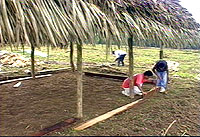
ALFONSO CAL:
The alcalde will go around to each family to visit them and tell them that they will put a date, what month that the fajina will be. Then all the people will know. If he has a job and the owner of the place don't want to give him some time and day off so he can pay.
If there's anybody's missing then there is where the alcalde charge them. Because they, we have promised already that we will give our word you know. They, they agree. And once they slip with that and not even with the money that they can't pay so now that we charge ten dollars for per day. And that is how we work. It operate very good.
HOST:
But what happens if someone doesn't pay the required $5 AND fails to show up for fajina?
GREG CHOC:
Most villagers recognize the importance of the alcalde so they will; they will turn up. And those that don't show up, again, because he is also, the sort of a magistrate in the community, he can charge those who disobey that order. It is a traditional law that is enforced by the alcalde.
MAYAN LEADERS
PEDRO KUKUL:
I think that the few that have gotten some info, some education, have realized that they owe quite a lot to their people. And I believe it's because of their exposure and by now seeing how their people have been treated that they are beginning to reflect. And it is more a motivation for them to say we need to help the people that we come from, you know. So you'll find now that Gregory will get involved in fighting for the cause because he realizes that there is quite a lot that needs to be done in terms of awakening the people.
GREG CHOC (President, Kekchi Council of Belize):
I think a large majority of the Maya population, particularly in the South, still don't feel themselves an integral part of Belize. And government care less to really look at what can we do to integrate them.
PEDRO KUKUL (Toledo District Education Officer):
I come from a village where there is no library there. No library, no electricity, no health center. It was just there so I had to come out and really work hard on my own. Right now most of the schools don't have telephones. If you want to get a message there, you need to go there in person. You know, so they are cut out completely. It was until lately that we had some communities with electricity. But not all communities have electricity. A few have telephones to communicate. It's very difficult.
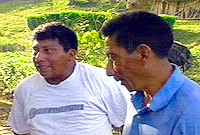
I didn't even take at that time the primary school leaving examination. But I had it in my mind that I will go through high school. And so regardless of those examinations I said I will go to high school. And I went through high school without repeating any grade. You know. But not many of our people, of my people have that, you know, initiative. They don't have that motivation.
GREG CHOC:
Because of the way the political system works in this country, the party politics has created a culture of dependency where communities who used to engage in what we call "fajina" or communal labour exchange, the whole issue of ah, building each others house, am, making each other plantations, helping each other, no longer exists.
The attitude of depending on the Minister to help the community; it has really, I guess, changed the value system of community. And our greatest challenge is to have community recognize the importance of independence. That they can do what they have to be begging the politicians for.
VALUE SYSTEM
GREG CHOC:
There has, always been a respect for the elders, a respect for the treatment of elders in our community, a respect for the environment. Those values, I find that it's no longer a part of the value system of youths that have migrated out of the communities and go back in.
Certainly I don't believe the elders are readily accepting the changes. You know, I talk to a lot of old people and there is that resentment. But they are also bombarded with the younger generation that are exposed, that are coming out, that have lived outside the community and have gone back. And so there is a clash. But I believe that for now the elders have been able to sustain the activities that they used to do. But it hinges on the acceptance of the newer generation - the new generation - on the values of what the older generation is trying to do.
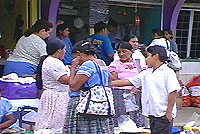
That's not to say that we should not integrate, that we should not take what is good from the other culture and strengthen our culture. Our culture is dynamic. It changes. It evolves. But I think it's important for us to recognize that there are certain aspects that accommodate development, that accommodate the development of an individual in a manner that is productive to society and there are also those that that impedes development.
What they see on the TV or what they see out there is not as real as they think it is, you know. But what they have is real. Having their land. Being able to grow their own food and not have to buy it is real. The ideal society that is being projected out there it's difficult to achieve it, you know. And this is what I think they aspire for.
And the greatest challenge, then, is how to reach to that point, how to ensure that we, as we move along, we are realistic as opposed to hinging our hopes on promise and ideals that that we cannot achieve.
HOST:
Thanks for watching. I'm Curtis Gillet.
See you next time on SIMPLY BELIZE: A Cultural Diary.
Click here for more photos
![]()
![]()
![]()
![]()
![]()
![]()
![]()
![]()
![]()
![]()
![]()
![]()
![]()
![]()
![]()
![]()
![]()
![]()
![]()
![]()